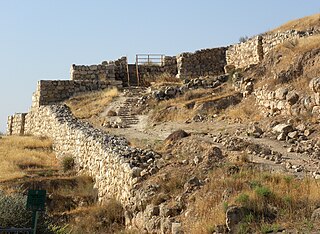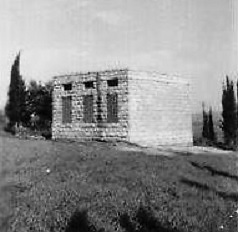
Lachish was an ancient Canaanite and Israelite city in the Shephelah region of Israel, on the south bank of the Lakhish River, mentioned several times in the Hebrew Bible. The current tell (ruin) by that name, known as Tel Lachish or Tell ed-Duweir, has been identified with the biblical Lachish. Today, it is an Israeli national park operated and maintained by the Israel Nature and Parks Authority. It lies near the present-day moshav of Lakhish.

Tel Megiddo is the site of the ancient city of Megiddo, the remains of which form a tell, situated in northern Israel near Kibbutz Megiddo, about 30 kilometres (19 mi) south-east of Haifa, at the western edge of Jezreel Valley. Megiddo is known for its historical, geographical, and theological importance, especially under its Greek name Armageddon. During the Bronze Age, Megiddo was an important Canaanite city-state. During the Iron Age, it was a royal city in the Kingdom of Israel.

Pre-Pottery Neolithic A (PPNA) denotes the first stage of the Pre-Pottery Neolithic, in early Levantine and Anatolian Neolithic culture, dating to c. 12,000 – c. 10,800 years ago, that is, 10,000–8800 BCE. Archaeological remains are located in the Levantine and Upper Mesopotamian region of the Fertile Crescent.

Tel Dor or Tell el-Burj, also Khirbet el-Burj in Arabic, is an archaeological site located on the Israeli coastal plain of the Mediterranean Sea next to modern moshav Dor, about 30 kilometers (19 mi) south of Haifa, and 2.5 kilometers (1.6 mi) west of Hadera. Lying on a small headland at the north side of a protected inlet, it is identified with D-jr of Egyptian sources, Biblical Dor, and with Dor/Dora of Greek and Roman sources.

The Timna Valley is located in southern Israel in the southwestern Arava/Arabah, approximately 30 kilometres (19 mi) north of the Gulf of Aqaba and the city of Eilat. The area is rich in copper ore and has been mined since the 5th millennium BCE. During early antiquity, the area would have been part of the Kingdom of Edom.

In the archaeology of Southwest Asia, the Late Neolithic, also known as the Ceramic Neolithic or Pottery Neolithic, is the final part of the Neolithic period, following on from the Pre-Pottery Neolithic and preceding the Chalcolithic. It is sometimes further divided into Pottery Neolithic A (PNA) and Pottery Neolithic B (PNB) phases.
The prehistory of the Levant includes the various cultural changes that occurred, as revealed by archaeological evidence, prior to recorded traditions in the area of the Levant. Archaeological evidence suggests that Homo sapiens and other hominid species originated in Africa and that one of the routes taken to colonize Eurasia was through the Sinai Peninsula desert and the Levant, which means that this is one of the most occupied locations in the history of the Earth. Not only have many cultures and traditions of humans lived here, but also many species of the genus Homo. In addition, this region is one of the centers for the development of agriculture.

Hamadia is a kibbutz in the Beit She'an Valley, just north of Beit She'an in northern Israel. It belongs to the Valley of Springs Regional Council. In 2021 it had a population of 421.

The Pre-Pottery Neolithic (PPN) represents the early Neolithic in the Levantine and upper Mesopotamian region of the Fertile Crescent, dating to c. 12,000 – c. 8,500 years ago,. It succeeds the Natufian culture of the Epipalaeolithic Near East, as the domestication of plants and animals was in its formative stages, having possibly been induced by the Younger Dryas.

Yosef Garfinkel is an Israeli archaeologist and academic. He is a professor of Prehistoric Archaeology and of Archaeology of the Biblical Period at the Hebrew University of Jerusalem.

Gesher is an archaeological site located on the southern bank of Nahal Tavor, near kibbutz Gesher in the central Jordan Valley of Israel. It bears signs of occupation from two periods, the very early Neolithic and the Middle Bronze Age. The site was first excavated between 1986 and 1987 by Yosef Garfinkel of the Hebrew University of Jerusalem and between 2002 and 2004 by Susan Cohen of Montana State University. The average of 4 radiocarbon dating results suggested inhabitation of the settlement around 8000 BC.

The Yarmukian culture was a Pottery Neolithic A (PNA) culture of the ancient Levant. It was the first culture in prehistoric Syria and one of the oldest in the Levant to make use of pottery. The Yarmukian derives its name from the Yarmuk River, which flows near its type site of Sha'ar HaGolan, near Kibbutz Sha'ar HaGolan at the foot of the Golan Heights. This culture existed alongside the Lodian, or Jericho IX culture and the Nizzanim culture to the south.

Abu Zurayq is an archaeological site located on the western edge of the Jezreel Valley and its transition to the Menashe Heights, next to Highway 66, between the modern kibbutzim of HaZore'a and Mishmar HaEmek.

The Khiamian culture is a Neolithic archaeological culture of Southwest Asia, dating to the earliest part of the Pre-Pottery Neolithic A (PPNA), around 9,700 to 8,600 BC. It is primarily characterised by a distinctive type of stone arrowhead—the "El Khiam point"—first found at the type site of El Khiam.
Abu Madi is a cluster of prehistoric, Neolithic tell mounds in Southern Sinai, Egypt. It is located east of Saint Catherine's Monastery at the bottom of a granite ridge. It was suggested to have been a seasonal encampment for groups of hunter gatherers and contained the remains of two major settlements; Abu Madi I and Abu Madi III. Abi Madi I is a small site with the remains of a partially buried 4 metres (13 ft) building containing deposits up to a depth of 1.3 metres (4.3 ft). Abu Madi III was an area of roughly 20 square metres (220 sq ft) that was excavated close to a large nearby boulder. Dwellings were found to have stone built silos next to them. It was first excavated in the early 1980s by Ofer Bar-Yosef.
Avi Gopher is an Israeli archaeologist. He is a professor at the University of Tel Aviv.
Munhata is an archaeological site 11 kilometres (6.8 mi) south of Lake Tiberias, Israel on the north bank and near the outlet of Nahal Tavor on a terrace 215 metres (705 ft) below sea level.

The Lodian culture or Jericho IX culture is a Pottery Neolithic archaeological culture of the Southern Levant dating from the first half of the 5th millennium BC, existing alongside the Yarmukian and Nizzanim cultures. The Lodian culture appears mainly in areas south of the territory of the Yarmukian culture, in the Shfela and the beginning of the Israeli coastal plain; the Judaean Mountains, and in the desert regions around the Dead Sea and south of it.
The Wadi Rabah culture is a Pottery Neolithic archaeological culture of the Southern Levant, dating to the middle of the 5th millennium BCE.
Sha'ar HaGolan is a Neolithic archaeological site near Kibbutz Sha'ar HaGolan in Israel. The type site of the Yarmukian culture, it is notable for the discovery of a significant number of artistic objects, as well as some of the earliest pottery in the Southern Levant.














